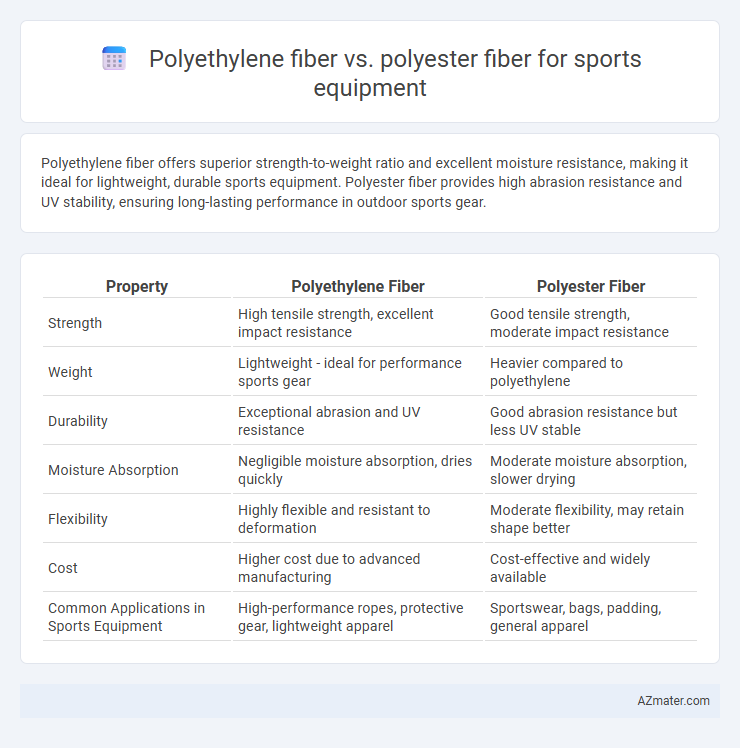Polyethylene fiber offers superior strength-to-weight ratio and excellent moisture resistance, making it ideal for lightweight, durable sports equipment. Polyester fiber provides high abrasion resistance and UV stability, ensuring long-lasting performance in outdoor sports gear.
Table of Comparison
| Property | Polyethylene Fiber | Polyester Fiber |
|---|---|---|
| Strength | High tensile strength, excellent impact resistance | Good tensile strength, moderate impact resistance |
| Weight | Lightweight - ideal for performance sports gear | Heavier compared to polyethylene |
| Durability | Exceptional abrasion and UV resistance | Good abrasion resistance but less UV stable |
| Moisture Absorption | Negligible moisture absorption, dries quickly | Moderate moisture absorption, slower drying |
| Flexibility | Highly flexible and resistant to deformation | Moderate flexibility, may retain shape better |
| Cost | Higher cost due to advanced manufacturing | Cost-effective and widely available |
| Common Applications in Sports Equipment | High-performance ropes, protective gear, lightweight apparel | Sportswear, bags, padding, general apparel |
Introduction to Polyethylene and Polyester Fibers in Sports Equipment
Polyethylene fiber, known for its ultra-high molecular weight and exceptional tensile strength, offers superior impact resistance and lightweight durability, making it ideal for protective sports gear like helmets and body armor. Polyester fiber provides excellent elasticity, moisture-wicking properties, and abrasion resistance, which enhances comfort and flexibility in sportswear and equipment such as jerseys and mats. Both fibers contribute unique performance advantages in sports equipment, with polyethylene excelling in protection and polyester optimizing comfort and durability.
Key Properties of Polyethylene Fiber
Polyethylene fiber excels in sports equipment due to its exceptional strength-to-weight ratio, high tensile strength, and excellent abrasion resistance, making it ideal for durable and lightweight gear. Its low moisture absorption and chemical resistance enhance performance in varying environmental conditions, ensuring longevity and consistent functionality. Compared to polyester fiber, polyethylene offers superior impact resistance and reduced weight, providing athletes with enhanced comfort and durability in high-performance applications.
Key Properties of Polyester Fiber
Polyester fiber stands out in sports equipment manufacturing due to its high tensile strength, excellent abrasion resistance, and low moisture absorption, which ensures durability and quick-drying performance during intense activities. Unlike polyethylene fiber, polyester offers superior UV resistance and color retention, making it ideal for outdoor sports gear exposed to sunlight. The fiber's ability to maintain shape and resist stretching also contributes to athletes' comfort and gear longevity.
Strength and Durability Comparison
Polyethylene fiber exhibits higher tensile strength and impact resistance compared to polyester fiber, making it ideal for sports equipment subjected to extreme forces. Its superior abrasion resistance and low moisture absorption contribute to enhanced durability and longevity in demanding outdoor conditions. Polyester fiber, while less strong, offers better elasticity and UV resistance, but generally falls short in heavy-duty applications requiring maximum structural integrity.
Flexibility and Comfort in Sports Applications
Polyethylene fiber offers superior flexibility and lightweight properties, making it ideal for sports equipment requiring high mobility and quick response. Polyester fiber provides excellent durability and moisture-wicking capabilities, enhancing comfort during intense physical activities by keeping the skin dry. For sports applications prioritizing flexibility and comfort, polyethylene fibers deliver enhanced agility, while polyester fibers ensure breathable and comfortable wear.
Moisture Wicking and Breathability
Polyester fiber excels in moisture-wicking properties due to its hydrophobic nature, efficiently drawing sweat away from the skin and promoting rapid evaporation, making it ideal for high-intensity sports equipment. Polyethylene fiber, though lightweight and strong, has lower breathability and moisture management compared to polyester, often leading to less effective sweat dispersion. Sportswear and equipment incorporating polyester fibers typically enhance comfort by maintaining dryness and improving airflow during physical activity.
Weight Considerations in Athletic Gear
Polyethylene fiber stands out for its exceptionally low density, making it significantly lighter than polyester fiber in sports equipment manufacturing. This weight advantage enhances athletic performance by reducing fatigue and improving agility in gear such as helmets, protective pads, and footwear. Although polyester fiber offers durability and moisture resistance, polyethylene's superior strength-to-weight ratio optimizes weight considerations critical for high-performance athletic applications.
Resistance to Abrasion and Environmental Conditions
Polyethylene fiber exhibits superior resistance to abrasion, making it highly durable for sports equipment subjected to rough surfaces and intense physical contact. It also offers excellent resistance to moisture, UV radiation, and chemicals, ensuring prolonged performance in diverse environmental conditions. Polyester fiber, while durable and UV-resistant, tends to absorb more moisture and may degrade faster under abrasive stress compared to polyethylene.
Cost and Sustainability Factors
Polyethylene fiber offers a lower cost and higher durability compared to polyester fiber, making it an economically attractive option for sports equipment manufacturing. Polyethylene's production consumes less energy and emits fewer greenhouse gases, enhancing its sustainability profile over polyester, which relies on more energy-intensive processes and petrochemical inputs. Both fibers provide strong performance characteristics, but polyethylene's cost-efficiency and reduced environmental impact position it as a preferred sustainable material in sports equipment.
Best Applications: Choosing the Right Fiber for Your Sport
Polyethylene fiber excels in sports equipment requiring high strength-to-weight ratio and superior impact resistance, making it ideal for helmets, protective gear, and high-performance racing suits. Polyester fiber offers excellent moisture-wicking properties and durability, suited for athletic apparel, sports jerseys, and equipment covers. Selecting the right fiber depends on the specific demands of the sport, with polyethylene prioritized for protection and lightweight needs, while polyester is favored for comfort and fabric resilience.

Infographic: Polyethylene fiber vs Polyester fiber for Sports equipment
 azmater.com
azmater.com